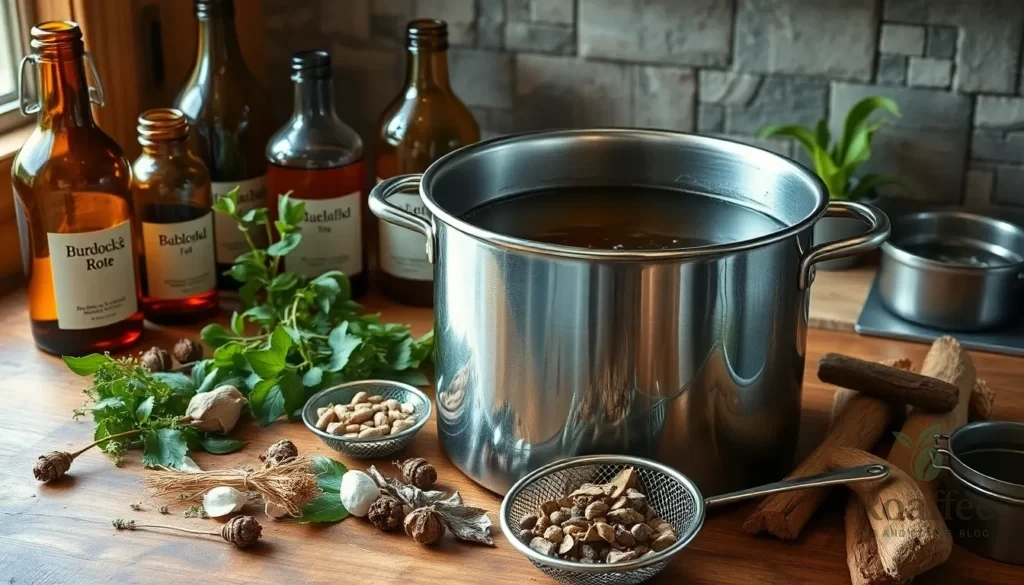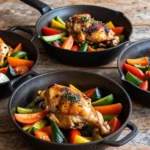We’ve all heard whispers about the legendary Essiac tea—a powerful herbal blend that’s captured attention across North America for nearly a century. This remarkable four-herb formula originated from traditional Ojibwe medicine and was later popularized by Canadian nurse Rene Caisse (whose surname spelled backward gives us “Essiac”). The tea combines burdock root, sheep sorrel, slippery elm bark, and Turkish rhubarb root in a exact ratio that creates a distinctive earthy brew.
What makes Essiac tea truly special isn’t just its fascinating history—it’s the careful preparation process that transforms these simple herbs into something extraordinary. We’ve perfected this traditional recipe to ensure you get the most authentic and potent brew possible right in your own kitchen.
Ready to discover why countless people have made this ancient remedy part of their daily wellness routine? Let’s jump into the time-tested method for brewing authentic Essiac tea.
What Is Essiac Tea
Essiac tea represents a powerful herbal blend that combines four exact medicinal plants in precise proportions. We recognize this traditional remedy as a carefully crafted formula that originated from Indigenous Ojibwe healing practices and gained prominence through the dedicated work of nurse Rene Caisse.
The foundation of authentic Essiac tea rests on four essential herbs that work synergistically together. Burdock root serves as the primary ingredient, providing the blend’s distinctive earthy base and contributing important therapeutic compounds. Sheep sorrel adds a subtle tartness while delivering vital nutrients and antioxidants. Slippery elm bark contributes a gentle, mucilaginous quality that creates the tea’s characteristic smooth texture. Turkish rhubarb root completes the formula with its bitter notes and potent active compounds.
We understand that the exact ratio of these herbs creates the tea’s unique therapeutic profile. The traditional formula calls for precise measurements that have remained unchanged for decades, ensuring consistency and potency in every batch. Each herb contributes distinct properties that complement the others, creating a harmonious blend that delivers more than the sum of its parts.
The preparation method transforms these raw botanical ingredients into a concentrated liquid extract. We follow a multi-step process that involves both boiling and steeping phases to extract the maximum beneficial compounds from each herb. The resulting tea exhibits a deep amber color with a complex flavor profile that balances earthy, bitter, and slightly sweet notes.
Quality sourcing of ingredients remains crucial for authentic Essiac tea preparation. We emphasize using organic herbs whenever possible to ensure purity and potency. The freshness of the herbs directly impacts the final product’s therapeutic value and taste characteristics.
Health Benefits and Traditional Uses
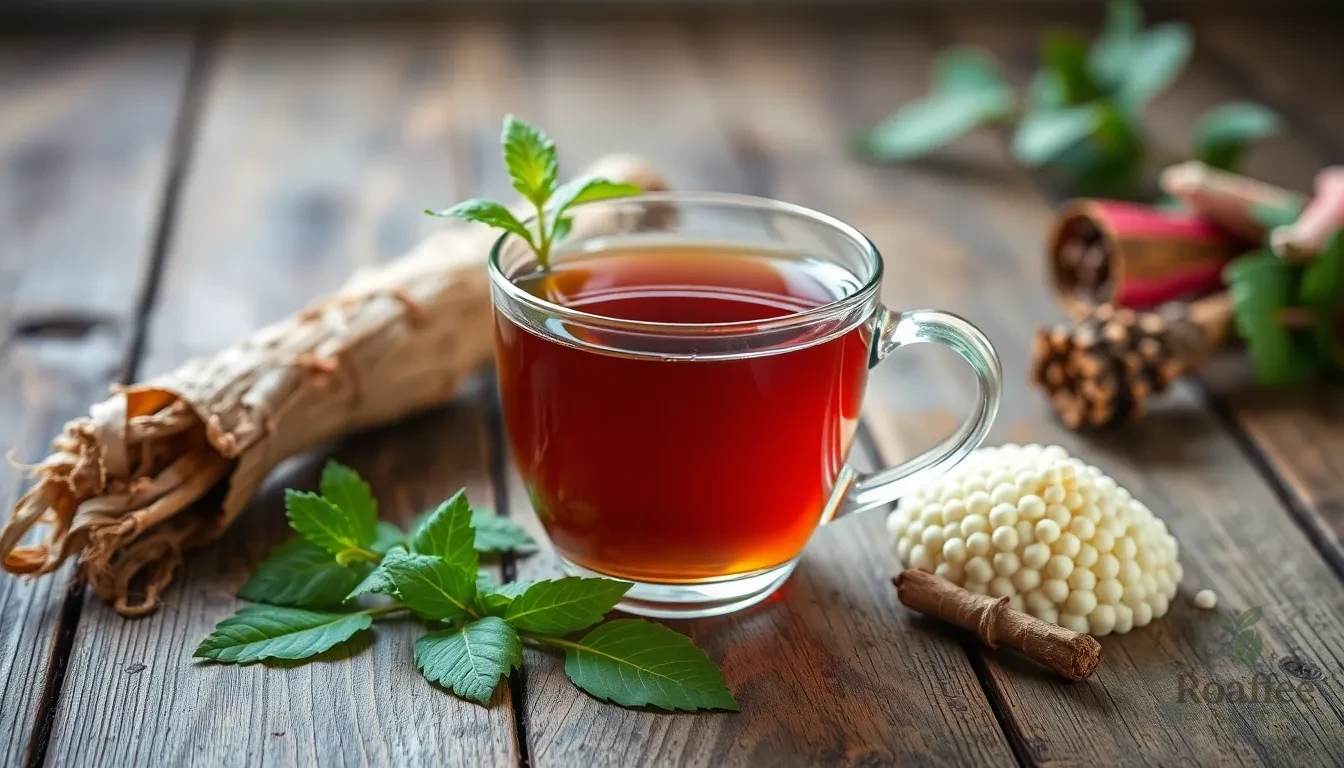
We’ve explored the fascinating origins and preparation methods of Essiac tea, and now we investigate into the remarkable health benefits and traditional applications that have made this herbal blend a cornerstone of natural wellness practices for nearly a century.
Anti-Cancer Properties and Scientific Research
Laboratory studies have shown promising results about Essiac tea’s potential anti-cancer effects. Research indicates that this herbal blend may slow the proliferation of leukemia and breast cancer cells while providing antioxidant effects that protect DNA from damage. We must emphasize that these findings come from early laboratory and animal studies rather than conclusive human clinical trials.
| Study Type | Cancer Type | Observed Effects |
|---|---|---|
| Laboratory Studies | Leukemia | Slowed cell proliferation |
| Laboratory Studies | Breast Cancer | Reduced cell growth |
| Animal Studies | Various Types | Antioxidant DNA protection |
Immune System Support and Detoxification
Traditional practitioners have long valued Essiac tea for its immune-boosting properties. The combination of burdock root, sheep sorrel, slippery elm bark, and Indian rhubarb root creates a synergistic effect that supporters believe enhances the body’s natural defense mechanisms. Many users report improved energy levels and enhanced detoxification processes when incorporating this tea into their daily routine.
Anti-Inflammatory Effects
Beyond its potential cancer-fighting properties, Essiac tea has been reported to reduce inflammation throughout the body. This anti-inflammatory action stems from the unique compounds present in each of the four herbs, which work together to address various inflammatory conditions naturally.
Historical and Traditional Applications
Nurse Rene Caisse first promoted Essiac tea in the 1920s, drawing from what was believed to be traditional Indigenous knowledge from Canada. Throughout the decades, people have used this herbal blend for various health conditions beyond cancer, including AIDS, diabetes, and digestive ailments. We recommend noting that typical daily consumption ranges from 1 to 12 ounces, depending on individual needs and manufacturer recommendations.
Important Safety Considerations
While Essiac tea is generally considered safe for healthy individuals when consumed in moderate amounts, we must address crucial safety information. The U.S. Food and Drug Administration (FDA) and Cancer Research UK do not approve Essiac tea for cancer treatment due to lack of conclusive scientific evidence from human clinical trials. Some studies indicate that certain components might inadvertently promote cancer cell growth under exact conditions, making professional consultation essential before beginning any regimen.
Essential Equipment and Tools
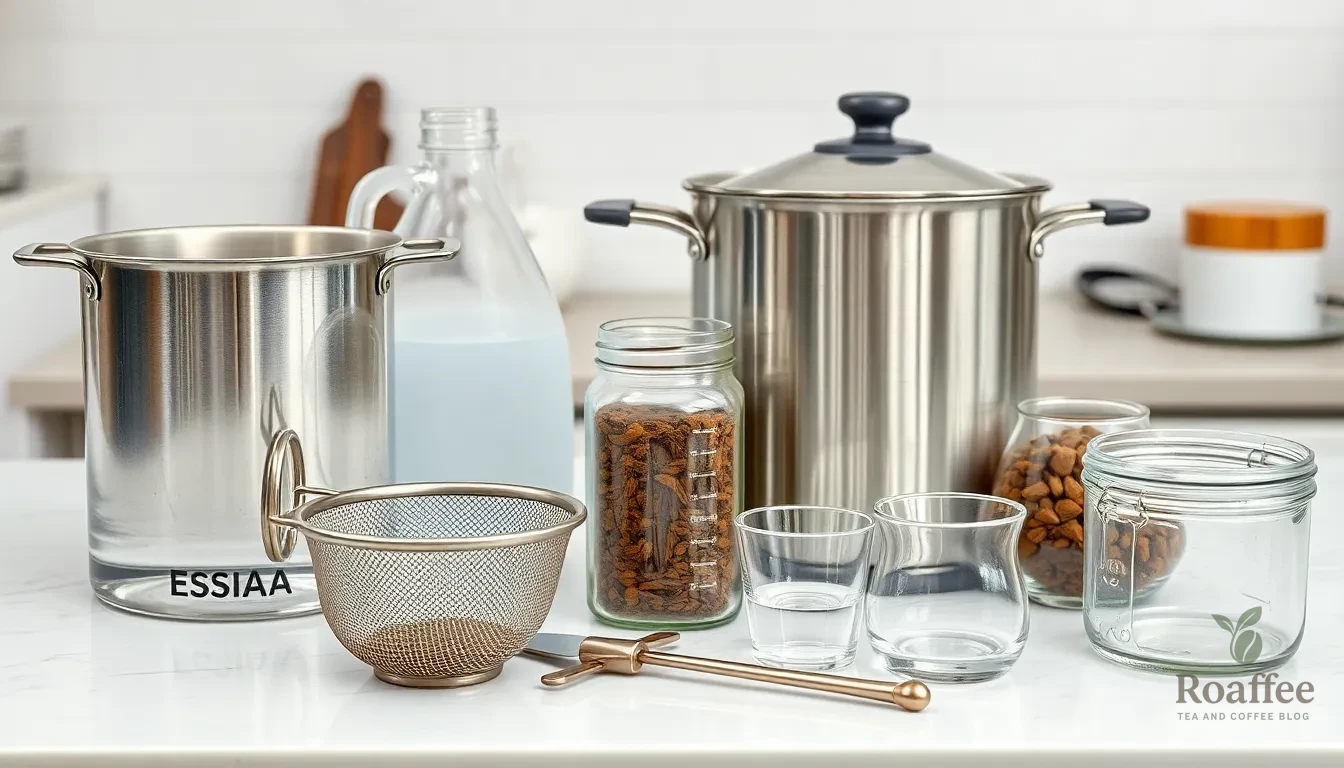
Preparing authentic Essiac tea requires exact equipment to ensure proper brewing and maximum extraction of beneficial compounds. We recommend gathering these essential tools before beginning your tea preparation to create the most effective and potent brew.
Large Pot or Kettle
A large pot serves as the foundation for brewing Essiac tea properly. We suggest using a stainless steel or enamel pot that can hold at least one gallon of liquid comfortably. The pot should be non-reactive to prevent any metallic taste from affecting the delicate herbal flavors. Size matters when brewing Essiac tea because you’ll need adequate space for the herbs to circulate freely during the boiling and simmering process.
Distilled Water Supply
Distilled water forms the base of your Essiac tea and directly impacts the final quality. We always use approximately one gallon of distilled water for each batch to ensure purity and avoid mineral interference. Tap water contains chlorine and other chemicals that can alter the tea’s therapeutic properties. Spring water may seem natural but can introduce unwanted minerals that affect extraction efficiency.
Straining Equipment
Proper straining equipment removes all herb solids from your finished tea. We recommend using either a fine mesh strainer or multiple layers of cheesecloth to filter the tea thoroughly. The straining process occurs after the steeping period and determines the clarity of your final product. Quality straining equipment prevents any plant material from remaining in your tea while allowing the beneficial compounds to pass through.
Precision Measuring Tools
Accurate measurements ensure consistent potency in every batch of Essiac tea. We use either a digital scale for weighing herbs or precise measuring cups for volume measurements. The traditional recipe relies on exact ratios between the four herbs. Measuring tools help maintain these proportions exactly as intended in the original formula.
Storage Container
A proper storage container preserves your brewed Essiac tea and maintains its therapeutic properties. We prefer glass containers because they don’t react with the tea or impart any flavors. The container should be large enough to hold your entire batch and have a tight fitting lid. Refrigeration becomes necessary once you’ve brewed your tea to prevent spoilage and maintain freshness.
| Equipment | Purpose | Recommended Material |
|---|---|---|
| Large Pot | Boiling and simmering | Stainless steel or enamel |
| Water | Base liquid | Distilled only |
| Strainer | Removing solids | Fine mesh or cheesecloth |
| Measuring Tools | Accurate proportions | Digital scale or measuring cups |
| Storage Container | Preservation | Glass with tight lid |
Ingredients

Creating authentic Essiac tea requires exact herbs and water quality to maintain the traditional formula’s integrity. We’ll guide you through the essential ingredients needed for this time-honored herbal blend.
Dried Herbs Required
The foundation of authentic Essiac tea rests on four exact dried herbs that must be measured precisely:
- Sheep sorrel – The primary ingredient that forms the largest portion of the blend
- Slippery elm bark – Provides the tea’s distinctive smooth texture and therapeutic properties
- Indian rhubarb root – Contributes bitter compounds essential for the tea’s traditional effects
- Burdock root – Adds earthy undertones and completes the herbal synergy
For one gallon of tea, we use 2 ounces (57 grams) of the combined herb mixture, which equals approximately half a cup of dried herbs. When preparing smaller batches such as one quart, we reduce the quantity to ½ ounce (14 grams) of the herb blend.
The herbs require careful sourcing to ensure maximum potency and therapeutic value. We recommend purchasing organic dried herbs from reputable suppliers who specialize in medicinal grade botanicals. Fresh herbs should be properly dried before use to concentrate their active compounds.
Water Requirements
Water quality significantly impacts the final tea’s effectiveness and flavor profile. We exclusively use distilled or unchlorinated water to preserve the herbs’ natural properties and prevent contamination from municipal water additives.
For one gallon of Essiac tea, we bring 5 to 5½ quarts of distilled water to a rolling boil. Smaller batches require 5 to 5½ cups of water for each quart of finished tea. The extra water accounts for evaporation during the boiling process.
Chlorinated tap water interferes with the herbs’ delicate compounds and can alter the tea’s therapeutic properties. Spring water serves as an acceptable alternative if distilled water is unavailable, provided it contains no added minerals or chemicals. We avoid using hard water or water with high mineral content as these can affect the extraction process and create unwanted sediment in the finished tea.
Instructions

We’ll guide you through the traditional brewing process that ensures maximum extraction of beneficial compounds from your Essiac tea blend. This time-tested method requires patience and attention to detail for optimal results.
Prep Stage
We measure exactly 16 level tablespoons (4 oz) of our Essiac tea mixture for 1 gallon of distilled water. For smaller batches we use 4 tablespoons (1 oz) of tea blend per 1 quart of water to maintain proper ratios.
We select only stainless steel or glass utensils for preparation since aluminum and other metals can interfere with the herbs’ natural properties. Our cooking vessels must be made from non-reactive materials to preserve the tea’s therapeutic compounds.
We gather all ingredients before starting the brewing process. Fresh spring water or distilled water provides the purest base for extraction while avoiding chlorinated tap water that could compromise the blend’s effectiveness.
Brewing Process
We bring our measured water to a rolling boil in a stainless steel pot over medium-high heat. The vigorous bubbling ensures proper temperature for initial extraction.
We stir in the measured Essiac tea mixture using a wooden or stainless steel spoon. Complete incorporation of the herbs prevents uneven brewing and ensures consistent potency throughout the batch.
We cover the pot and reduce heat to maintain a gentle simmer for exactly 10 minutes. This initial cooking phase begins the extraction process while preventing over-boiling that could damage delicate compounds.
We remove the pot from heat and stir the mixture thoroughly before covering it again. The tea must sit undisturbed for 12 hours either at room temperature or refrigerated to allow complete extraction of active compounds.
After 12 hours we stir the mixture once more and return it to the stove. We bring the tea back to a boil and simmer for another 10 minutes to complete the traditional brewing cycle.
Straining and Filtering
We strain the brewed tea through a fine mesh strainer or colander to remove all herb particles. Multiple passes through the strainer ensure complete filtration of plant material.
We use a funnel to pour the filtered tea into clean amber glass bottles for optimal storage. Glass containers preserve the tea’s potency while protecting it from light degradation.
We cap the bottles tightly after the tea cools to room temperature. Proper sealing prevents oxidation and maintains freshness during storage.
Our finished tea stays fresh for 2 to 3 weeks when stored in the refrigerator. We shake the bottle well before each use since natural settling may occur during storage.
We dilute 2 oz of our prepared Essiac tea with 2 oz of boiling distilled water before drinking. This dilution method follows traditional preparation guidelines for optimal consumption.
Directions for Proper Storage
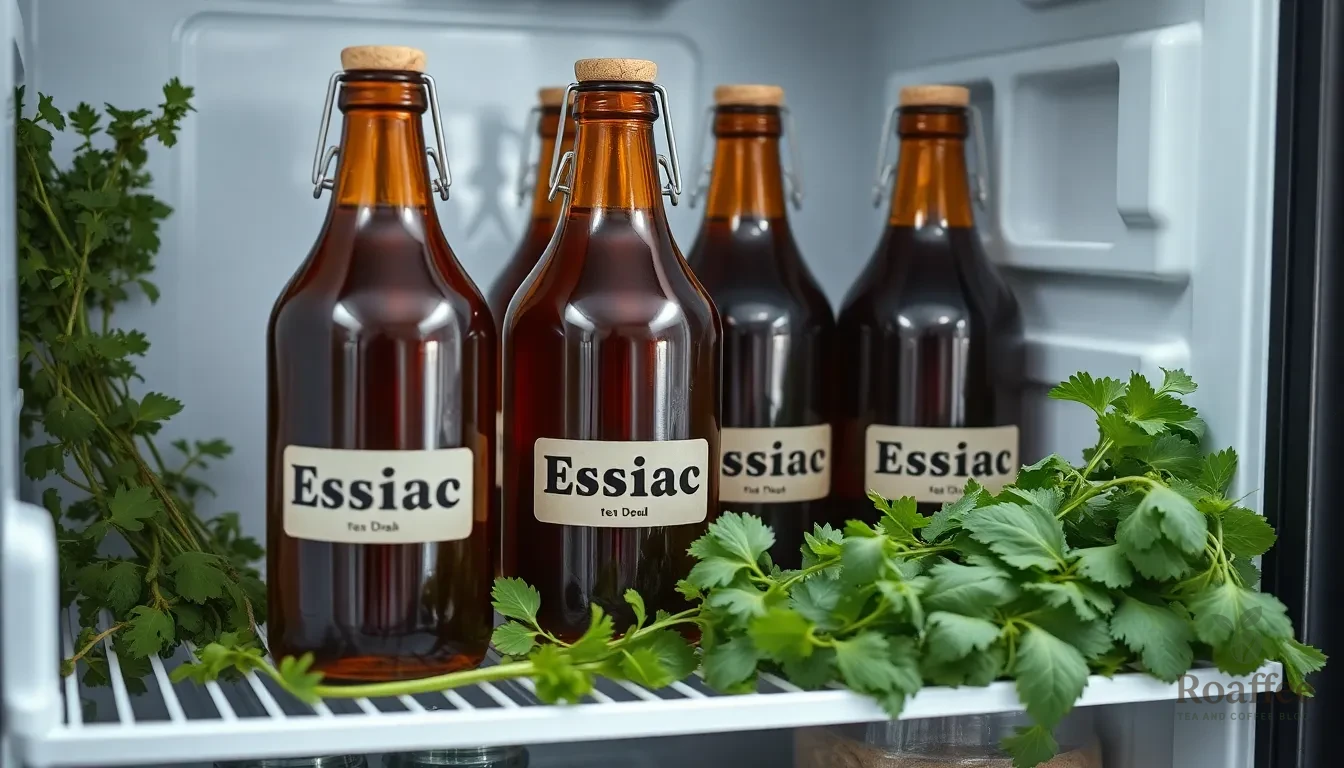
Proper storage of Essiac tea is crucial for maintaining its potency and preventing contamination. We recommend storing your freshly prepared tea concentrate in the refrigerator immediately after it cools to room temperature. The tea maintains its therapeutic properties for 2 to 3 weeks when properly refrigerated in sealed amber glass bottles.
Refrigeration Requirements
Store all sealed tea bottles in the refrigerator as soon as preparation is complete. Once you open a bottle, keep it refrigerated and consume the contents quickly to prevent deterioration. We strongly advise against leaving opened bottles at room temperature for extended periods.
Container Selection and Placement
Only airtight preserving jars can store Essiac tea in a cool, dark cupboard as an alternative to refrigeration. But, refrigerated storage remains our preferred method for optimal freshness and safety. Use amber glass bottles exclusively for storage, as they protect the tea from light degradation while maintaining its beneficial compounds.
Storage Duration Guidelines
| Storage Method | Duration | Container Type |
|---|---|---|
| Refrigerated (sealed) | 2-3 weeks | Amber glass bottles |
| Refrigerated (opened) | Use quickly | Amber glass bottles |
| Cool cupboard | 2-3 weeks | Airtight preserving jars only |
Handling Leftover Herbs
The strained herbs remaining after brewing can be refrigerated for several days if you plan to use them as poultices. Store these leftover herbs in a separate container from your prepared tea to maintain organization and prevent cross-contamination.
Safety Monitoring
Inspect your stored tea regularly for any signs of spoilage or mold formation. Discard the tea immediately if you notice any mold growth, unusual odors, or changes in appearance. We cannot stress enough the importance of maintaining strict hygiene standards throughout the storage process to ensure your tea remains safe for consumption.
Serving Suggestions

Now that we’ve brewed our Essiac tea concentrate, let’s explore the traditional serving methods that maximize its therapeutic potential. The way we prepare and consume this herbal blend can significantly impact our experience and the tea’s effectiveness.
Hot Tea Preparation
We recommend starting with 2 ounces of our prepared tea concentrate for each serving. Pour this concentrated tea into a clean glass or ceramic mug to avoid any metallic interference with the herbs’ natural properties.
Next, we add 2 ounces of boiling fresh spring or distilled water to dilute the concentrate to drinking strength. The hot water should be freshly boiled rather than reheated to ensure optimal taste and maintain the tea’s therapeutic integrity.
Stir the mixture gently and allow it to cool slightly before consuming. We suggest drinking this hot preparation on an empty stomach for maximum absorption of the beneficial compounds. The ideal timing is either first thing in the morning or at least 2 hours after eating.
Cold Tea Preparation
For those who prefer a cooler beverage, we can serve our Essiac tea concentrate directly from the refrigerator. Shake the bottle well before pouring to ensure all settled particles are properly mixed throughout the liquid.
Measure 2 to 4 ounces of the cold concentrate into a glass and drink it straight without dilution. This method preserves all the concentrated herbal compounds while providing a refreshing alternative to the hot preparation.
We can also create a lukewarm version by adding a small amount of room temperature distilled water to the cold concentrate. This approach offers a middle ground between the hot and cold serving methods while maintaining the tea’s potency.
| Serving Method | Concentrate Amount | Water Amount | Temperature | Best Timing |
|---|---|---|---|---|
| Hot Tea | 2 oz | 2 oz boiling water | Warm | Empty stomach |
| Cold Tea | 2-4 oz | None | Cold | Empty stomach |
| Lukewarm | 2-3 oz | 1-2 oz room temp | Cool | Empty stomach |
The optimal daily intake ranges from 2 to 4 ounces total, with many people finding 3 ounces per day divided into 2 doses works best for their routine. We always consume Essiac tea on an empty stomach to ensure the herbs can work without interference from food digestion.
Dosage and Consumption Guidelines
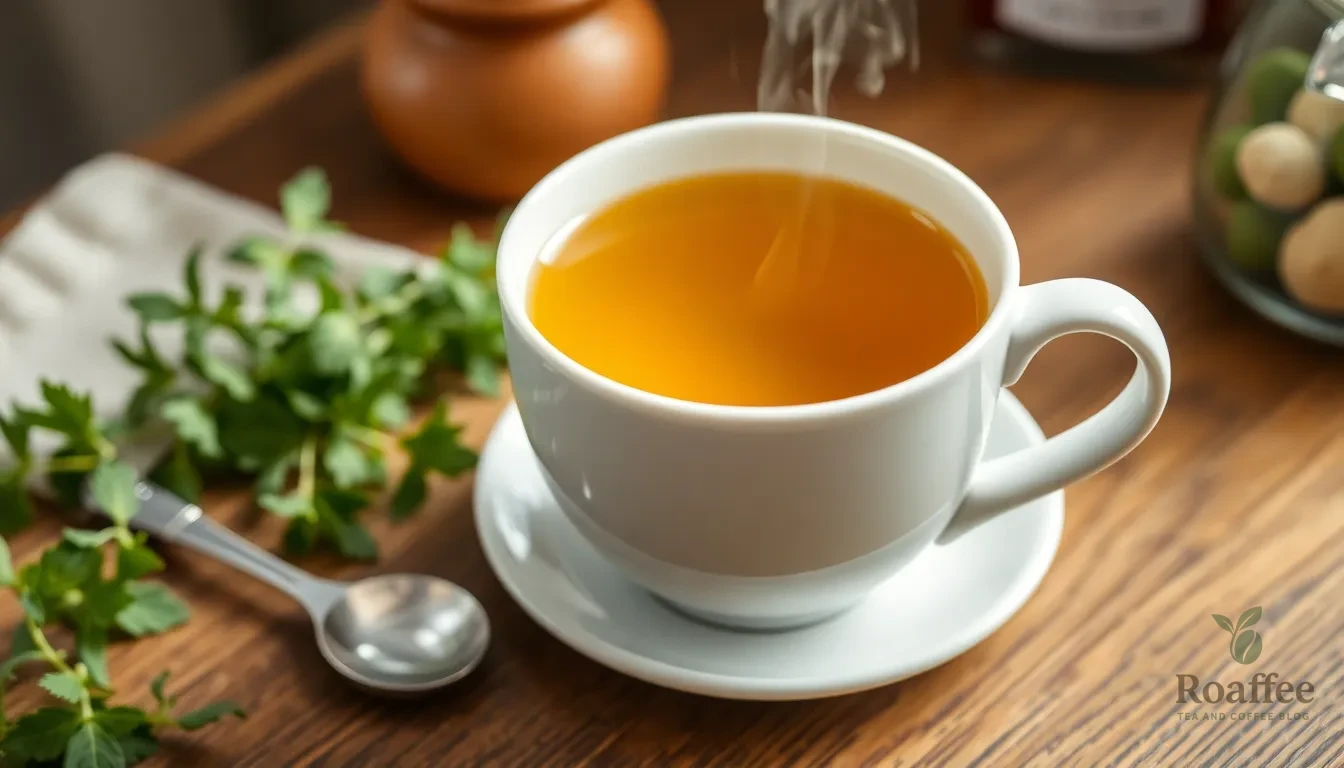
Proper dosage and timing are crucial for maximizing the therapeutic benefits of Essiac tea. We recommend following the traditional guidelines established by nurse Rene Caisse to ensure optimal absorption and effectiveness.
Traditional Dosage Protocol
The original method suggested by Rene Caisse involves a structured approach to consumption. We advise drinking 1 ounce of Essiac tea concentrate diluted with 2 ounces of hot water on an empty stomach. This mixture should be consumed 2 to 3 hours after supper every other day for 32 days during the initial phase.
After completing the first 32 days, we recommend reducing the frequency to 1 ounce every 3 days for maintenance purposes. This tapering approach allows your body to adjust while maintaining the tea’s beneficial effects.
Modern Consumption Guidelines
Contemporary usage patterns vary based on individual needs and tolerance levels. Many people consume 4 to 6 ounces daily, adjusting the amount based on their personal response to the tea. We suggest starting with smaller amounts and gradually increasing as your body becomes accustomed to the herbal blend.
| Dosage Phase | Amount | Frequency | Duration |
|---|---|---|---|
| Initial Phase | 1 oz (diluted) | Every other day | 32 days |
| Maintenance | 1 oz | Every 3 days | Ongoing |
| Modern Approach | 4-6 oz | Daily | As needed |
Simple Preparation Method
For those preferring a simpler approach, we recommend steeping 1 teaspoon of Essiac tea blend in boiling water for 5 minutes. Strain the mixture thoroughly before drinking to remove any herb particles that could cause irritation.
Timing and Absorption
Empty stomach consumption is essential for optimal absorption of the tea’s active compounds. We suggest waiting at least 2 hours after eating before consuming your dose. This timing ensures the herbs can be properly absorbed without interference from food digestion.
Morning consumption on an empty stomach can also be effective for many users. Wait at least 30 minutes after drinking the tea before eating breakfast to allow for complete absorption.
Safety Considerations
We strongly recommend consulting with healthcare providers before beginning any Essiac tea regimen, especially if you have existing health conditions or take medications. The tea should be consumed within 1 to 2 weeks of preparation when stored properly in the refrigerator.
Monitor your body’s response during the first few weeks of consumption. Some users may experience mild detoxification symptoms as their bodies adjust to the herbal compounds. Adjust the dosage if you experience any adverse reactions.
Commercial Essiac products often include detailed dosage booklets with exact instructions for adults, children, and pets. These guidelines can provide additional reference points for safe consumption practices.
Make-Ahead Instructions
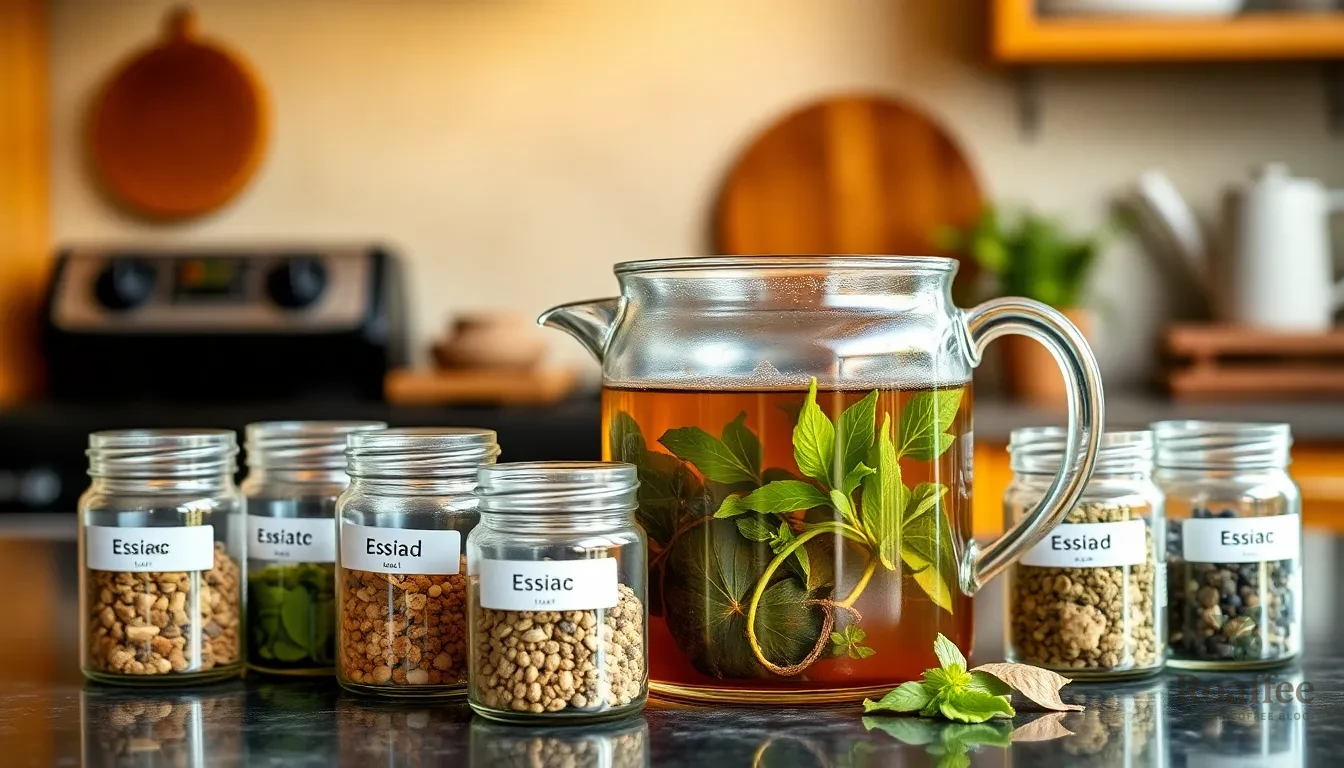
We recommend preparing Essiac tea in advance to ensure you always have this therapeutic blend ready when needed. The traditional preparation method naturally lends itself to batch cooking since the process takes several hours to complete properly.
Batch Preparation Timeline
Start your preparation 24 hours before you plan to consume the tea. The initial brewing phase requires 10 minutes of active cooking time followed by a 12-hour refrigeration period. After refrigeration we bring the mixture back to a boil for another 10 minutes before the final straining process.
Large Batch Preparation
We suggest preparing one gallon of concentrate at a time using 16 tablespoons of the herbal mixture. This quantity provides approximately 16 servings when diluted according to traditional guidelines. Store the finished concentrate in multiple amber glass bottles rather than one large container to minimize exposure to air each time you open a bottle.
Weekly Meal Prep Strategy
Planning your Essiac tea preparation for Sunday evenings works well for most schedules. Begin the first brewing phase Sunday evening around 6 PM. The tea will be ready for its second boiling phase Monday morning and can be strained and bottled by Monday afternoon. This timing ensures fresh tea availability throughout the week.
Advance Herb Preparation
We recommend measuring out individual batches of the herbal mixture in advance. Store pre-measured portions in airtight containers labeled with preparation dates. This approach eliminates measuring time during the actual brewing process and ensures consistent ratios for each batch.
Storage Duration Planning
| Storage Method | Duration | Quality Notes |
|---|---|---|
| Refrigerated concentrate | 2-3 weeks | Maintains full potency |
| Frozen concentrate | 2-3 months | Slight potency reduction |
| Dried herb mixture | 12-18 months | Store in cool, dark place |
Multiple Batch Strategy
Consider preparing two batches with staggered timing to ensure continuous availability. Start the second batch when the first batch reaches its halfway point of recommended storage time. This rotation system guarantees you never run out of fresh concentrate while maintaining optimal potency.
Preparation Scheduling
Mark your calendar for brewing days to maintain consistency. The 12-hour refrigeration period means timing becomes crucial for maintaining your daily routine. We find that starting the process after dinner allows for completion the following evening without disrupting work schedules.
Tips for Best Results
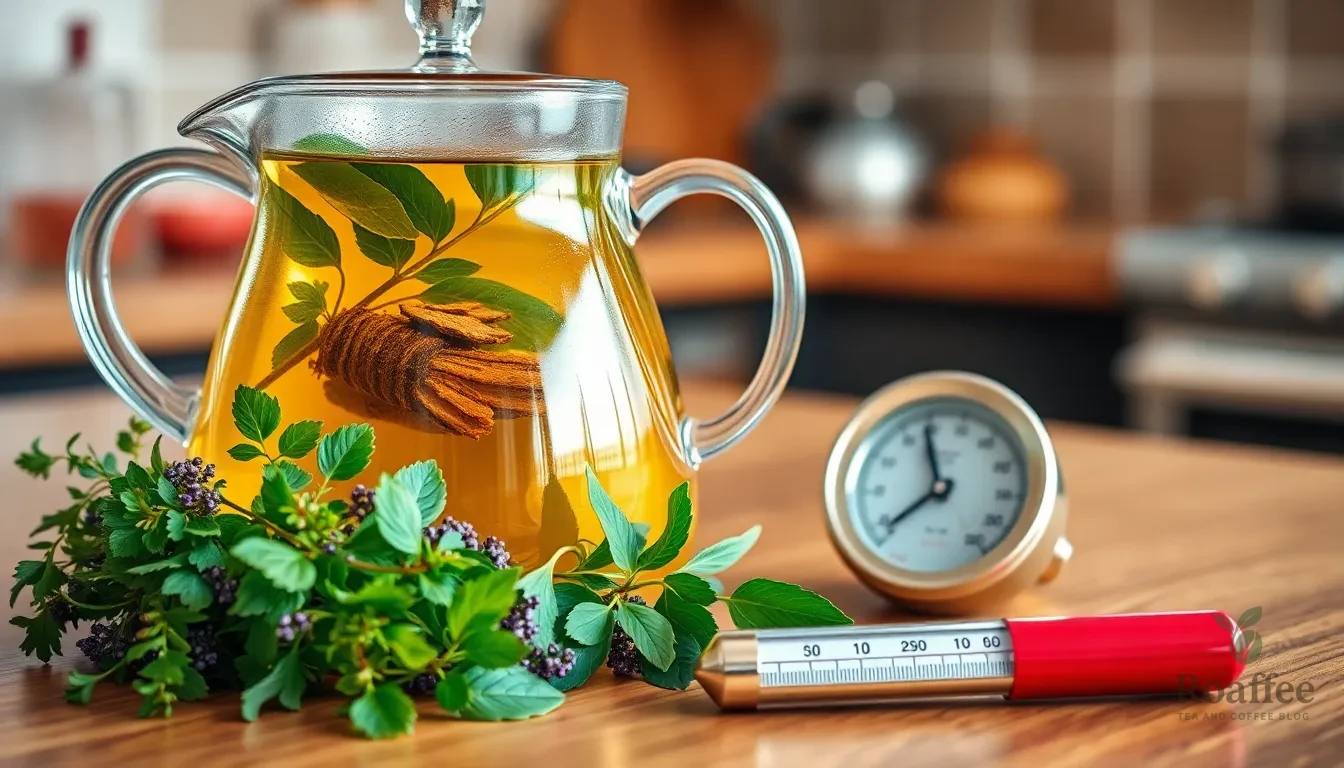
We recommend following these essential guidelines to maximize the therapeutic potential of your Essiac tea and ensure consistent quality with every batch.
Temperature Control During Brewing
Maintaining precise temperature control creates the optimal environment for extracting beneficial compounds from each herb. We suggest using a reliable thermometer to monitor water temperature and keeping the simmer gentle rather than vigorous. Rolling boils can destroy delicate compounds in the herbs while insufficient heat fails to extract the full therapeutic value. The ideal simmering temperature ranges between 185°F and 195°F for complete extraction without damaging the herbs’ beneficial properties.
Timing Is Everything
Adhering to the traditional 10-minute simmering periods ensures proper extraction of each herb’s active compounds. We never rush this process as shorter brewing times result in weaker tea while longer periods can create bitter flavors and potentially harmful concentrations. Setting multiple timers helps us track both brewing phases accurately. The 12-hour refrigeration period between brewing sessions allows the herbs to fully release their therapeutic compounds into the water.
Quality Control Measures
Inspecting herbs before brewing prevents contamination and ensures maximum potency in every batch. We examine each herb for signs of mold, unusual odors, or discoloration that might indicate spoilage. Fresh herbs should maintain their characteristic colors and aromas. Testing small batches before preparing larger quantities helps us verify the quality of new herb supplies.
Proper Dilution Techniques
Measuring concentrate and water precisely maintains the traditional therapeutic ratios established by Rene Caisse. We use accurate measuring tools rather than estimating portions to ensure consistent dosing. The standard 1:1 ratio of concentrate to boiling water creates the optimal strength for therapeutic benefits. Adjusting this ratio based on personal tolerance should be done gradually and with careful observation of effects.
Storage Optimization
Protecting prepared tea from light and air exposure preserves its therapeutic compounds throughout the storage period. We store concentrate in amber glass bottles filled to the top to minimize air contact. Refrigeration temperatures between 35°F and 40°F maintain optimal freshness. Labeling bottles with preparation dates helps us track freshness and rotate stock appropriately.
Consumption Timing
Taking Essiac tea on an empty stomach maximizes absorption and therapeutic effectiveness. We recommend waiting at least 2 hours after meals before consuming the tea and avoiding food for 30 minutes afterward. Morning consumption often works best as it allows the body to process the herbs throughout the day. Establishing a consistent daily routine helps maintain steady therapeutic levels in the system.
Equipment Maintenance
Cleaning all equipment thoroughly between batches prevents contamination and maintains the purity of each preparation. We use only non-reactive cleaning agents and ensure all surfaces are completely dry before storing. Stainless steel and glass equipment require different cleaning approaches to maintain their integrity. Regular inspection of strainers and storage containers helps identify potential issues before they affect tea quality.
Where to Source Quality Herbs
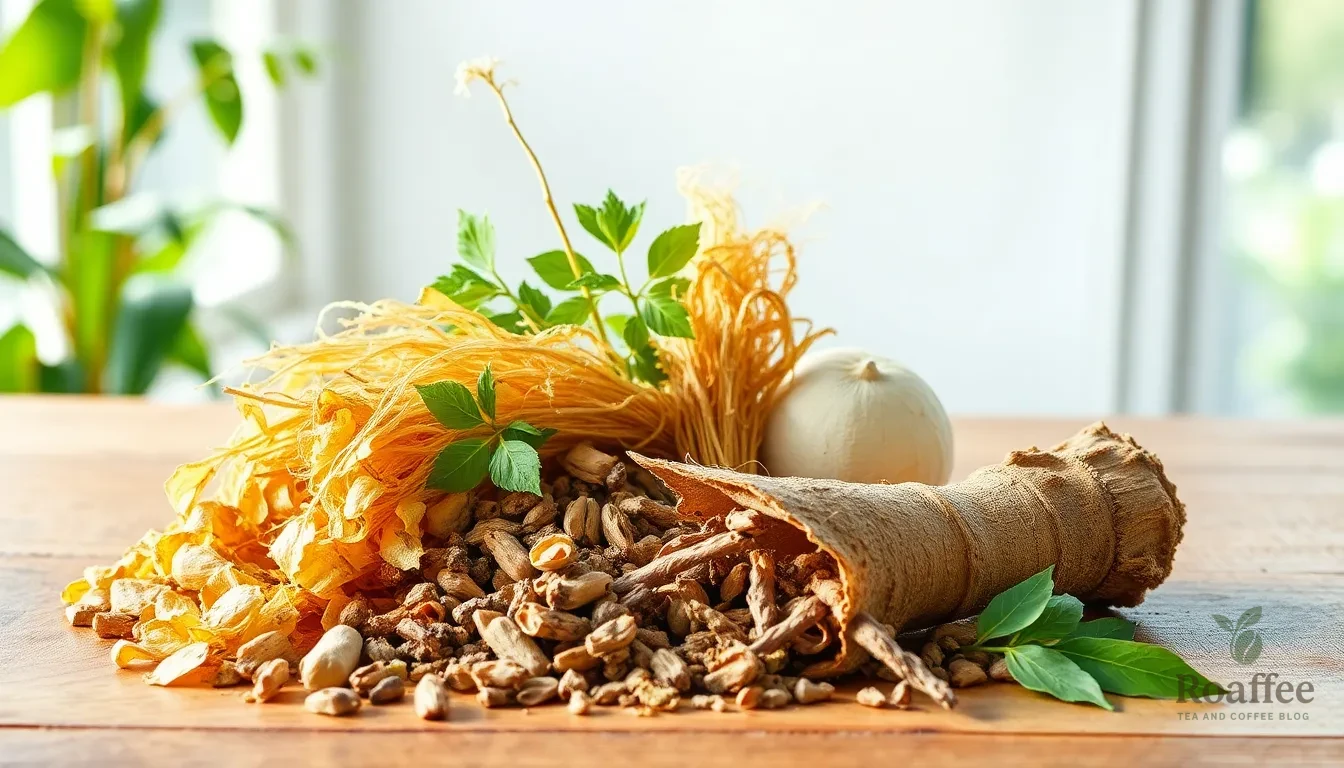
Finding authentic Essiac tea ingredients requires careful attention to supplier credentials and product specifications. We recommend purchasing from trustworthy suppliers specializing in organic or wildcrafted herbs to avoid contaminants and ensure potency. Quality sourcing directly impacts the therapeutic effectiveness of our finished tea.
Identifying Reputable Suppliers
Organic certification serves as our primary indicator of herb quality. Suppliers with transparent sourcing practices provide detailed information about their harvesting methods and storage conditions. We prioritize vendors who offer complete ingredient profiles and batch testing results.
Brands such as Essiac Canada International hold rights to the original formula and offer some assurance of authenticity. These established suppliers maintain stricter quality controls and provide certificates of analysis for their products.
Essential Quality Markers
Sheep sorrel root inclusion stands as the most critical factor when evaluating Essiac tea blends. We look for powders or dried herbs that specify inclusion of the sheep sorrel root, which is critical to authentic Essiac tea. Many inferior products omit this crucial component or substitute less effective alternatives.
Complete herb profiles separate authentic products from incomplete formulations. Quality suppliers clearly list all four traditional herbs: sheep sorrel with root, burdock root, slippery elm inner bark, and Indian rhubarb root. Some practitioners prefer modern formulations that add watercress, blessed thistle, red clover, and kelp for enhanced potency.
Avoiding Inferior Products
Cheap or incomplete blends lack the full complement of traditional herbs and may be ineffective or counterfeit. We examine ingredient lists carefully to ensure all components meet traditional specifications. Price alone should not determine our purchasing decisions when therapeutic effectiveness is at stake.
Supplier transparency about herb origins and processing methods helps us identify reliable sources. Companies that provide detailed sourcing information and third-party testing results demonstrate commitment to quality standards.
Quality Assurance Factors
| Quality Factor | What to Look For |
|---|---|
| Certification | Organic certification from recognized bodies |
| Transparency | Clear sourcing and processing information |
| Completeness | All four traditional herbs included |
| Root Inclusion | Sheep sorrel specifically with root |
| Testing | Third-party lab results available |
| Authenticity | Licensed or authorized suppliers |
Wildcrafted herbs often provide superior potency compared to commercially cultivated varieties. We seek suppliers who harvest herbs in their natural environments using sustainable practices. These herbs typically contain higher concentrations of active compounds.
Storage conditions at the supplier level affect herb quality significantly. Quality vendors maintain proper temperature and humidity controls throughout their supply chain. We verify that suppliers store herbs in dark, cool environments to preserve their therapeutic properties.
Conclusion
We’ve walked you through the complete journey of creating authentic Essiac tea from sourcing quality herbs to perfecting your brewing technique. This traditional remedy offers a meaningful way to incorporate centuries-old wisdom into your modern wellness routine.
Success with Essiac tea comes down to attention to detail – using the right herb ratios maintaining proper brewing temperatures and following traditional preparation methods. When you source organic herbs from reputable suppliers and store your concentrate properly you’ll maximize the tea’s therapeutic potential.
Remember that consistency matters more than perfection when starting your Essiac tea journey. Start with smaller batches to perfect your technique then scale up as you become more comfortable with the process. We encourage you to approach this ancient remedy with patience and respect for its rich heritage.
Your commitment to quality preparation will reward you with a potent therapeutic tea that connects you to generations of traditional healing wisdom.
Frequently Asked Questions
What is Essiac tea?
Essiac tea is a legendary herbal blend with roots in traditional Ojibwe medicine, popularized by Canadian nurse Rene Caisse. It consists of four specific herbs: burdock root, sheep sorrel, slippery elm bark, and Turkish rhubarb root, prepared in a precise ratio to create its distinctive flavor and therapeutic properties.
What are the health benefits of Essiac tea?
Laboratory studies suggest Essiac tea may have anti-cancer properties, potentially slowing leukemia and breast cancer cell proliferation. It’s also valued for immune-boosting properties, detoxification support, improved energy levels, and anti-inflammatory effects. However, it’s not FDA-approved for cancer treatment and should not replace professional medical care.
How do I prepare Essiac tea?
To prepare authentic Essiac tea, boil distilled water in a stainless steel or enamel pot, add the herbal mixture, and simmer for 10 minutes at 185°F-195°F. Strain the tea through fine mesh or cheesecloth, then store the concentrate in amber glass bottles in the refrigerator for 2-3 weeks.
What equipment do I need to make Essiac tea?
You’ll need a large stainless steel or enamel pot, distilled water, fine mesh strainers or cheesecloth, precise measuring tools for correct herb ratios, and amber glass storage containers. Using proper non-reactive materials is essential for maintaining the tea’s therapeutic properties and preventing contamination.
How much Essiac tea should I drink daily?
The traditional dosage is 1 ounce of diluted concentrate every other day for 32 days, then 1 ounce every three days for maintenance. Modern users often consume 4-6 ounces daily, adjusted for personal tolerance. Always drink on an empty stomach for optimal absorption and consult healthcare providers before starting.
How long does Essiac tea last?
Freshly prepared Essiac tea concentrate can be stored in sealed amber glass bottles in the refrigerator for 2-3 weeks. Always inspect stored tea for signs of spoilage before consumption. Dried herb mixtures can be stored for longer periods when kept in airtight containers away from light and moisture.
Where can I buy quality Essiac tea herbs?
Purchase from reputable suppliers specializing in organic or wildcrafted herbs, such as Essiac Canada International. Look for organic certification, transparency in sourcing practices, and complete herb profiles including sheep sorrel root. Avoid inferior products that lack the full complement of traditional herbs or proper quality controls.
Can I make Essiac tea ahead of time?
Yes, batch cooking is recommended for convenience. Start preparation 24 hours before consumption, including a 12-hour refrigeration period. One gallon of concentrate using 16 tablespoons of herbal mixture yields approximately 16 servings. Consider weekly meal prep on Sunday evenings for continuous availability.
What type of water should I use for Essiac tea?
Use distilled or unchlorinated water to preserve the herbs’ natural properties and prevent contamination. Avoid chlorinated tap water or hard water, as these can affect the tea’s therapeutic qualities and interfere with proper extraction of beneficial compounds during the brewing process.
Are there any safety considerations with Essiac tea?
While generally safe for healthy individuals in moderate amounts, Essiac tea is not FDA-approved for medical treatment. Consult healthcare providers before starting any regimen, especially if you have existing health conditions. The tea should complement, not replace, professional medical care and treatment.

